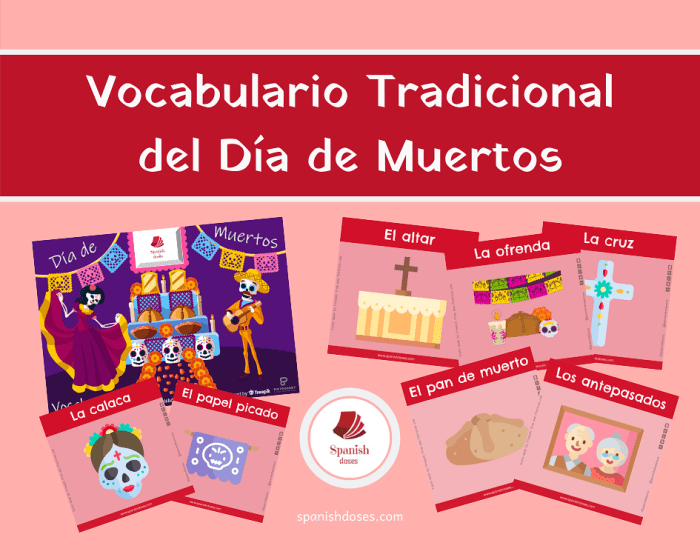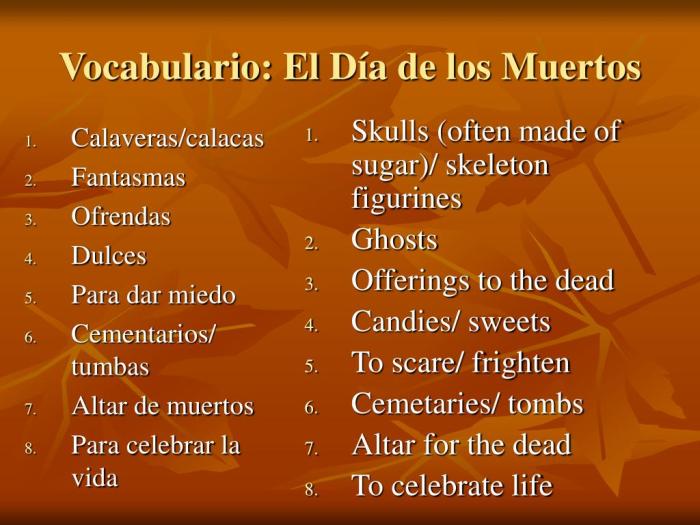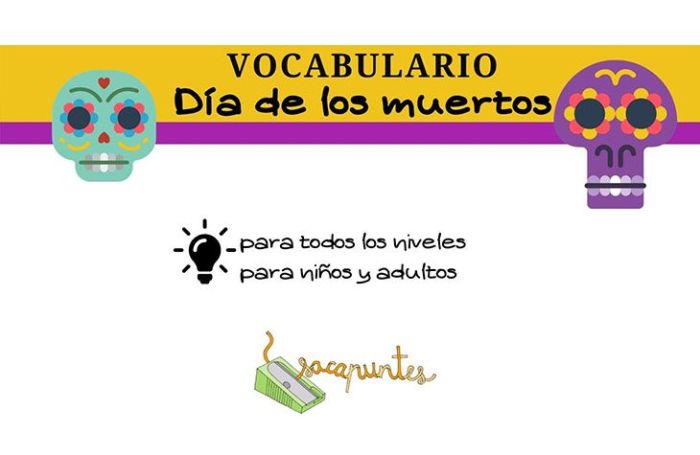Dia de los Muertos Vocabulario is an essential guide to the Spanish vocabulary surrounding the vibrant Mexican holiday of Day of the Dead. Explore the rich traditions and cultural significance behind each word, gaining a deeper understanding of this captivating celebration.
From traditional practices to symbolic offerings, this comprehensive resource unveils the essence of Dia de los Muertos, offering insights into its historical roots and regional variations.
Vocabulario esencial

Dia de los Muertos, or Day of the Dead, is a vibrant and meaningful holiday celebrated in Mexico and other parts of the world. To fully appreciate the significance of this celebration, it’s essential to understand some key Spanish vocabulary words associated with it.
These words not only convey the cultural traditions and beliefs surrounding the holiday but also help us connect with the spirit of the day.
Altar (Al-tar)
An altar is a sacred space created to honor and remember deceased loved ones. It is typically decorated with flowers, candles, food, and other offerings that represent the deceased’s personality and interests.
Calaveras (Ka-la-ve-ras)
Calaveras are decorative sugar skulls that symbolize death and rebirth. They are often adorned with colorful designs and inscriptions, representing the playful and lighthearted nature of the holiday.
Cementerio (Se-men-te-rio)
A cementerio is a cemetery where the deceased are buried. During Dia de los Muertos, families visit the graves of their loved ones, decorate them with flowers and offerings, and spend time remembering their lives.
Flores de Cempasúchil (Flo-res de Sem-pa-soo-chil)
Marigolds, known as Flores de Cempasúchil, are bright orange flowers that are believed to guide the spirits of the deceased back to their homes during Dia de los Muertos. Their vibrant color and strong scent are said to attract the souls.
Ofrendas (O-fren-das)
Ofrendas are offerings placed on altars to honor and appease the spirits of the deceased. They can include food, drink, toys, clothing, and other items that the deceased enjoyed in life.
Pan de Muerto (Pan de Mwer-to)
Pan de Muerto is a sweet bread that is traditionally baked for Dia de los Muertos. It is shaped like a skull or bones and is often decorated with sugar and sesame seeds.
Tradiciones y costumbres
Dia de los Muertos, also known as the Day of the Dead, is a Mexican holiday that celebrates the lives of deceased loved ones. It is a time for families and friends to come together to remember and honor their departed, and to share stories, food, and drinks.
There are many traditional practices and customs associated with Dia de los Muertos, each with its own unique symbolism and cultural significance. Some of the most common traditions include:
Ofrendas
Ofrendas are offerings that are made to the deceased on Dia de los Muertos. They are typically placed on a table or altar in the home, and they may include food, drinks, flowers, candles, and other items that the deceased person enjoyed in life.
Ofrendas are a way to show respect for the deceased and to help them on their journey to the afterlife. They are also a way for the living to connect with their loved ones who have passed away.
Visiting the cemetery
On Dia de los Muertos, it is customary to visit the cemetery where the deceased are buried. Families and friends will often bring flowers, candles, and other offerings to the graves of their loved ones, and they will spend time there praying, singing, and sharing stories.
Visiting the cemetery is a way to remember the deceased and to honor their memory. It is also a time for families and friends to come together and to support each other.
Eating pan de muerto
Pan de muerto is a sweet bread that is traditionally eaten on Dia de los Muertos. It is typically made with anise and orange zest, and it is often decorated with sugar skulls or other symbols of the holiday.
Pan de muerto is a symbol of life and death. The anise represents the deceased, while the orange zest represents the living. Eating pan de muerto is a way to remember the deceased and to celebrate the cycle of life.
Altares y ofrendas

The creation of altars and offerings is a core tradition of Dia de los Muertos. These altars serve as symbolic representations of the deceased and a means of honoring their memory. Families carefully construct altars in their homes, adorned with elements that hold special significance in their connection to the deceased.
An altar typically consists of several essential components:
Fotos
Photographs of the deceased are prominently displayed on the altar, serving as a tangible connection to their memory. These photos are often accompanied by personal mementos, such as clothing or other cherished objects, further personalizing the altar and evoking memories of the departed.
Velas
Candles represent the light that guides the spirits of the deceased back to their families on Dia de los Muertos. Each candle symbolizes a deceased loved one, and their flames are believed to illuminate the path for their return. The number of candles on an altar varies depending on the number of deceased family members being honored.
Flores
Flowers, particularly marigolds, are an integral part of Dia de los Muertos altars. Marigolds, known as “flor de muerto” (flower of the dead), are believed to possess a unique scent that attracts the spirits of the deceased. Their vibrant colors and strong fragrance create a welcoming and inviting atmosphere on the altar.
Comida
Food offerings on Dia de los Muertos altars hold deep significance. Families prepare the deceased’s favorite dishes, believing that the spirits return to partake in the feast. Traditional offerings include pan de muerto (bread of the dead), a sweet bread often shaped like skulls or bones, and tamales, a corn-based dish wrapped in corn husks.
These offerings symbolize the nourishment and sustenance provided to the deceased in the afterlife.
Exploring the rich vocabulary of “Dia de los Muertos,” we encounter terms like “calavera” and “ofrenda.” These concepts resonate with the intricate tapestry of deception woven throughout “The Great Gatsby” ( deception in the great gatsby ) . Gatsby’s opulent facade conceals a past shrouded in mystery, mirroring the duality of life and death in “Dia de los Muertos.”
Comida y bebidas

Dia de los Muertos is a time to remember and honor the dead, and food and beverages play an important role in the festivities. Traditional dishes and drinks are prepared and offered to the deceased as a way to show respect and affection.
Pan de Muerto, Dia de los muertos vocabulario
Pan de Muerto, or “Bread of the Dead,” is a sweet bread that is shaped like a skull or a round loaf with bones on top. It is often decorated with sesame seeds or sugar and is a popular offering on Dia de los Muertos altars.
Calabaza en Tacha
Calabaza en Tacha is a traditional Mexican dessert made from pumpkin, piloncillo (unrefined cane sugar), and cinnamon. It is a sweet and flavorful dish that is often served warm.
Tamales
Tamales are a popular Mexican dish made from cornmeal dough that is filled with various ingredients, such as meat, cheese, or vegetables. They are wrapped in corn husks and steamed until cooked.
Atole
Atole is a hot, thick beverage made from cornmeal or masa harina. It is often flavored with chocolate, vanilla, or fruit and is a popular drink on Dia de los Muertos.
Tequila
Tequila is a Mexican distilled spirit made from the agave plant. It is a popular drink on Dia de los Muertos and is often used in cocktails.
Celebraciones en México: Dia De Los Muertos Vocabulario
The Dia de los Muertos is a vibrant and colorful holiday celebrated in Mexico and other parts of Latin America. In Mexico, the holiday is celebrated from October 31st to November 2nd, and it is a time to remember and honor deceased loved ones.
The celebrations vary from region to region, but there are some common traditions that are observed throughout the country.
In many parts of Mexico, families build altars in their homes to honor their deceased loved ones. These altars are typically decorated with candles, flowers, food, and other offerings. Families also visit the graves of their loved ones and decorate them with flowers and other decorations.
Local Festivals
In addition to family celebrations, there are also many public events and festivals that take place during the Dia de los Muertos. In Mexico City, the Zócalo is transformed into a giant altar, and there are parades and other events throughout the city.
In Oaxaca, the Guelaguetza festival is held during the Dia de los Muertos, and it features traditional music, dance, and food.
Parades
Parades are a common sight during the Dia de los Muertos in Mexico. These parades often feature people dressed in costumes, and they are a way to celebrate the lives of the deceased and to remember their loved ones.
Other Public Gatherings
In addition to parades, there are also other public gatherings that take place during the Dia de los Muertos. These gatherings often include music, dance, and food, and they are a way for people to come together and celebrate the holiday.
Frequently Asked Questions
What is the significance of “ofrendas” in Dia de los Muertos?
Ofrendas are offerings placed on altars to honor and remember the deceased. They typically include photos, candles, flowers, food, and other items that were meaningful to the departed.
How is Dia de los Muertos celebrated in different regions of Mexico?
While the core traditions remain consistent, Dia de los Muertos celebrations vary regionally. In some areas, it is a somber time for mourning, while in others it is a lively festival with music, dancing, and parades.